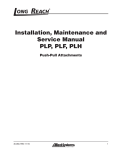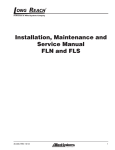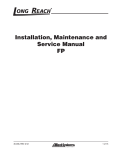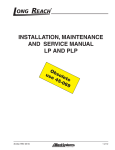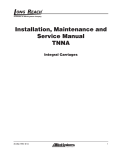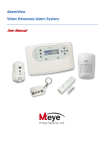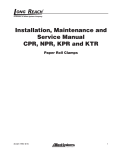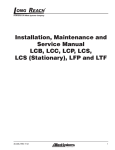Download Installation, Maintenance and Service Manual for Integrally Mounted
Transcript
Installation, Maintenance and Service Manual for Integrally Mounted Carriages 45-039, REV. 9/12 1 TABLE OF CONTENTS SECTION 1 NAMEPLATE LOCATION.......... 3 SECTION 4 SERVICE................................. 12 4.1 Fork Removal.............................................. 12 SECTION 2 SAFETY SUMMARY................. 4 4.2 Fork Inspection............................................ 12 2.1 Safety Information......................................... 4 4.3 Fork Installation........................................... 12 2.2 Safety Regulations........................................ 4 4.4 Integral Carriage Removal, Installation and Adjustment......................... 12 2.3 Safety Symbols.............................................. 4 2.4 Operation Warnings....................................... 4 2.5 Hydraulic Hazards ........................................ 4 2.6 Electrical Hazards......................................... 5 2.7 Maintenance Warnings.................................. 5 2.8 Training.......................................................... 6 2.9 Labeling......................................................... 6 2.10 Pre-start Checks.......................................... 6 2.11 Personnel Safety......................................... 6 2.12 Load Handling............................................. 7 2.13 Load Positioning.......................................... 7 2.14 Truck Requirements..................................... 7 2.15 Operator’s Controls ..................................... 8 2.16 Industry Standards...................................... 8 2.17 Clamp Open Control.................................... 8 SECTION 3 INSTALLATION........................ 10 3.1 Truck Requirements..................................... 10 4.5 Fork Frame Removal................................... 12 4.6 Fork Frame Disassembly............................. 12 4.7 Fork Frame Inspection................................. 14 4.8 Fork Frame Reassembly............................. 14 4.9 Fork Frame Installation................................ 14 4.10 Sideshift Cylinder Removal....................... 14 4.11 Sideshift Cylinder Disassembly................. 15 4.12 Sideshift Cylinder Inspection..................... 15 4.13 Sideshift Cylinder Repair........................... 16 4.14 Sideshift Cylinder Assembly...................... 16 4.15 Sideshift Cylinder Installation.................... 16 4.16 Fork Positioner Cylinder Removal............. 17 4.17 Fork Positioner Cylinder Disassembly............................................. 17 4.18 Fork Positioner Cylinder Repair................. 17 4.19 Fork Positioner Cylinder Assembly.......... 17 4.20 Fork Positioner Cylinder Installation................................................ 18 3.2 Hydraulics.................................................... 10 3.3 Carriage Installation.................................... 10 SECTION 5 MAINTENANCE...................... 19 3.4 Hydraulic Connections................................. 10 5.1Torque Specifications.................................. 19 2 45-039, REV. 9/12 SECTION 1 NAMEPLATE LOCATION Notice When you receive your integral carriage, locate the Long Reach nameplate (upper left corner on the body). Record the information from the nameplate, along with the date received, at the bottom of this page. If the nameplate is missing, look for the serial number stamped directly into the metal at the nameplate location and consult the factory for details. APPROX. S/N PLATE LOCATION Date received: - 45-039, REV. 9/12 - 3 SECTION 2 SAFETY SUMMARY 2.1 Safety Information Safety is Everyone’s Responsibility Whether you are new on the job or a seasoned veteran, these safety tips may prevent injury to you, to others, or to the materials you are handling. Always be alert, watch out for others, and follow these suggestions: Attachments handle material, not people. Safety starts with common sense, good judgement, properly maintained equipment, careful operation, and properly trained operators. The safety instructions and warnings, as documented in this manual and shipped with the machine, provide the most reliable procedures for the safe operation and maintenance of your Long Reach attachment. It’s your responsibility to see that they are carried out. 2.2 Safety Regulations Know your company’s safety rules. Some companies have site-specific directions and procedures. The methods outlined in your operator's manual provide a basis for safe operation of the machine. Because of special conditions, your company’s material handling procedures may be somewhat different from those shown in this manual. Caution Indicates a hazardous situation which, if not avoided, could result in minor or moderate injury, or equipment damage or void the machine warranty. Carefully read the message that follows to prevent minor or moderate injury. Notice Describes information that is useful but not safety related. Caution All possible safety hazards cannot be foreseen so as to be included in this manual. Therefore, the operator must always be alert to possible hazards that could endanger personnel or damage to the equipment. Obey the following warnings before using your machine to avoid equipment damage, personal injury or death. 2.3 Safety Symbols 2.4 Operation Warnings The following terms define the various precautions and notices: • You must be trained to operate this equipment prior to operation. Be extremely careful if you do not normally operate this machine. Reorient yourself to the machine before starting, then proceed slowly. Danger Indicates a hazardous situation which, if not avoided, will result in death or serious injury. Carefully read the message that follows to prevent serious injury or death. 4 • Always operate an attachment from the driver’s seat. • Always lower the attachment if you need to leave the lift truck. A lift truck supporting a load requires your full attention. 2.5 Hydraulic Hazards Warning Danger Indicates a hazardous situation which, if not avoided, could result in death or serious injury. Carefully read the message that follows to prevent serious injury or death. Small hydraulic hose leaks are extremely dangerous, and can inject hydraulic oil under the skin, even through gloves. Infection and gangrene are possible when hydraulic oil penetrates the skin. See a doctor immediately to prevent loss of limb or death. 45-039, REV. 9/12 • Wear personal protective equipment, such as gloves and safety glasses, whenever servicing or checking a hydraulic system. • Include attachments in a scheduled maintenance and inspection program. Tailor inspection steps to the attachment. • Assume that all hydraulic hoses and components are pressurized. Relieve all hydraulic pressure before disconnecting any hydraulic line. • Unless specified in service procedures, never attempt maintenance or lubrication procedures while the machine is moving or the engine is running. • Never try to stop or check for a hydraulic leak with any part of your body; use a piece of cardboard to check for hydraulic leaks. • Always perform all maintenance and lubrication procedures with the machine on level ground, parked away from traffic lanes. Notice Local laws and regulations may require that additional safety measures be taken. 2.6 Electrical Hazards Warning Remain at least 25 feet from high voltage electrical wires. Failure to do so may result in injury or death and will damage equipment. • All electrical cables and connectors must be in good condition (free of corrosion, damage, etc). Use caution in wet weather to avoid danger from electrical shock. Never attempt electrical testing or repair while standing in water. • Never rely on the hydraulic system to support any part of the machine during maintenance or lubrication. Never stand under a component that is supported only by the hydraulics. Make sure it is resting on its mechanical stops or appropriate safety stands. • Use caution when working around hot fluids. Always allow lubricating and hydraulic oils to cool before draining. Burns can be severe. • Use extreme caution when using compressed air to blow parts dry. The pressure should not exceed 30 psi (208 kPa) at the nozzle. Never use compressed air on yourself. Air pressure penetrating your skin can be fatal. • Engine exhaust fumes can cause death. If it is necessary to run the engine in an enclosed space, remove the exhaust fumes from the area with an exhaust pipe extension. Use ventilation fans and open shop doors to provide adequate ventilation. • Do not wear electrically conductive jewelry, clothing, or other items while working on the electrical system. 2.7 Maintenance Warnings Maintenance, lubrication and repair of this machine can be dangerous unless performed properly. You must have the necessary skills and information, proper tools and equipment. Work in a method that is safe, correct, and meets your company’s requirements. • Do not attempt to make adjustments, or perform maintenance or service unless you are authorized and qualified to do so. 45-039, REV. 9/12 • Before disconnecting hydraulic lines, be sure to lower all loads and relieve all hydraulic pressure. The load could fall on you, or escaping hydraulic oil could cause severe personal injury. • Prevent personal injury or equipment damage by using a lifting device with a lifting capacity greater than twice the weight of any equipment to be lifted. 5 2.8 Training • Make sure all operators are trained in the fork and attachment adaptation, operation, and use limitations. Retrain an operator if a new attachment is added to the forklift. Consult the operator’s manual for instructions on how to use the new equipment. • Know the mechanical limitations of your forklift. • Keep hands, feet, long hair and clothing away from power-driven parts. Do not wear loose fitting clothing or jewelry while performing maintenance and lubrication in these areas. • Never jump on or off the machine. • Never stand on top of material being raised, lowered, or transported. (Figure 2-1) • Modifications or additions that affect capacity or safe operation must have prior written approval from the forklift truck manufacturer. Capacity, operation, and maintenance instruction plates, tags, or decals shall be changed accordingly. • Never use free rigging for a below-the-forks lift. It could affect the capacity and safe operation of a lift truck. 2.9 Labeling • Change capacity, operation, and maintenance instruction plates, tags, or decals when a forklift truck is equipped with an attachment. If the truck is equipped with front-end attachments other than factory installed attachments, truck must be marked to identify the attachments and show the approximate weight of the truck and attachment combination at maximum elevation with load laterally centered. Figure 2-1 2.10 Pre-start Checks • Check your equipment before you operate it. If anything looks wrong, unusual or different, report it before using the attachment. • Do not operate this machine if you know of malfunctions, missing parts, and/or mis-adjustments. These situations can cause or contribute to an accident or damage to the machine. Stop the machine immediately if problems arise after starting. Figure 2-2 • Check to make sure the attachment on your truck is the same as on the truck capacity plate. • Check for hydraulic leaks and cracked hoses or fittings. Check the hydraulic oil level in the lift truck hydraulic reservoir. • All electrical cables and connectors must be in good condition. Use caution in wet weather to avoid danger from electrical shock. • Always check the attachment for proper fit and engagement of the truck carriage. 2.11 Personnel Safety • When removing or installing dismountable attachments always keep hands and feet free from dangerous positions or pinch points. Never leave a dismounted attachment in a dangerous position. 6 Figure 2-3 • Never use the attachment or its load to support a man-carrying device. • Never allow anyone under a load or under the carriage. (Figure 2-2) • Never stand in front of or beside an attachment that is being operated. Never allow another person to approach an attachment that is being operated. (Figure 2-3) • Never leave an attachment or load in an elevated position. 45-039, REV. 9/12 • Never reach through the mast of the truck. Keep all parts of the body within the driver’s compartment. • Always ensure that the load is the same width as the pallet and neatly stacked when using a carton clamp. • Always operate an attachment from the operator’s seat, never while standing next to the lift truck. 2.13 Load Positioning • Do not allow riders on the truck at any time. • Always use reverse when carrying a load that impedes full vision. Watch for pedestrians when transporting. • Be accurate in load placement. It’s important to know what the load will do when it’s released. 2.12 Load Handling • Always carry loads as close to the floor as possible, consistent with the surface being traversed. Scraping or bumping the floor surface with the load or the attachment can severely damage the attachment and cause product damage. The mast should be tilted back. • Treat an unloaded forklift with an attachment as partially loaded. • Always keep the load positioned as close as possible to the horizontal center of the lift truck. • Never overload the attachment. Refer to the attachment nameplate for the rated capacity of the attachment. Refer to the truck nameplate for the maximum net working capacity of the truck/attachment combination. Never use a load to support or move another object. Doing so can easily exceed the holding capacity of the attachment. • Always back down ramps or inclines. Driving forward down a ramp or incline with a clamped load will lessen the stability of the truck. (Figure 2-4) • Always use personal protective equipment (PPE) appropriate to the situation. • Always check loads to be handled. Correct loads that are broken, unbalanced, loose, or too heavy. • Never lift, lower, side shift, pivot, rotate, or tilt loads while traveling. Repositioning loads while traveling affects the stability of the truck and may impede vision or clearances. • Do not use an attachment to open or close boxcar doors. Doing so can severely damage the attachment and cause loss of warranty. Damage to clamp arms may result in product damage. • Do not carry loose items or unsupported loads on top of a clamped load. • Never use chains, cables, or other devices in conjunction with an attachment for load handling. • Never clamp loads other than what the attachment was designed to handle. • Always carry cylindrically shaped loads in the vertical position, not the horizontal. • Always clamp loads with the contact pads, if applicable, not the arm or arm base. • Never rotate a load that is off center to the centerline of rotation. Severe damage to the rotator could result. 45-039, REV. 9/12 Figure 4 • Do not cross dock boards or dock levelers with the attachment or carriage fully lowered. Ramming the front or rear of the attachment against a dock board can cause severe damage. • Limit lift truck movement to a minimum when high stacking. Limit sideshift movement to a minimum when high stacking. • Always be observant when high stacking. Look for poorly stacked loads, overhead obstacles, broken cartons, or damaged products in the stack. • Travel slowly around corners. Sound horn on blind corners. Be careful of tail swing and overhead clearances. Watch in all directions. Avoid sudden stops. 2.14 Truck Requirements Prior to connecting the truck hydraulic system to the attachment, the truck hydraulic system must be cleaned through the filtration system. This will eliminate any contamination that may exist in the auxiliary hydraulic system of the truck. 7 Warning The capacity of the truck and attachment combined may be less than the attachment capacity. Consult truck nameplate. Notice The dealer and/or the user are responsible for installing any valving required to meet the recommended hydraulic pressures and flow. The required valving can be furnished by the dealer, the truck factory or Long Reach. Lifting speed is controlled by the speed of the engine and the position of the control lever. Engine speed has no effect on lowering speed. Before going on the job, shift the truck control levers one way and then the other to determine which direction the attachment moves when the levers are shifted. Make sure the attachment moves smoothly throughout its travel, without binding or pinching hoses. Warning If the attachment does NOT operate smoothly, do not take it on the job. Check with your supervisor about needed repairs to avoid injury or equipment damage. 2.15 Operator’s Controls 2.16 Industry Standards Some lift trucks are equipped with a single lever to control both hoist and tilt functions, others have separate levers for each function. Refer to your lift truck manual for more information. ANSI/ITSDF B56.1-2009 is the published sequence and direction standard for lever- and hand-type controls. For clarity, the direction of arm movement is shown on the control handle. To move the arms in the direction shown, pull the handle towards the operator. To move the arms in the opposite direction, the push the handle away from the operator. (Figure 2-5) Notice The chart on the following page shows industry standards. Your equipment may be different. If you do not routinely operate this equipment, refresher training is recommended. You must reacquaint yourself with this manual and the equipment before starting, and then proceed slowly. Special controls such as automatic devices should be identified, preferably according to the recommendations in Figure 2-6. Clamp Fork position When a function is controlled by a pair of push buttons, they should operate in the same sense as the lever controls. For example, pushing a button located to the rear (relative to the operator’s position) should serve the same function as moving a control lever to the rear. 2.17 Clamp Open Control Push/pull Rotate Sideshift Figure 2-5 Operator controls 8 Effective October 7, 2010, a new safety standard (ANSI/ ITSDF B56.1, Section 7.25.7) for all lift trucks with a load bearing clamp (paper roll clamp, carton clamp, etc.) requires the driver to make two distinct motions before opening or releasing the clamp. For example, you must press a switch and then move a lever to unclamp the load. This requirement applies to new and used attachments being mounted on new trucks shipping from the factory after October 7, 2010, and is a recommended feature to be installed on dealer orders and existing applications. 45-039, REV. 9/12 Direction of motion Function Load Hoist Reach Tilt Sideshift Push-pull Rotate, lateral Rotate, longitude Load stabilizer Swing Slope Fork position Trip Grip Truck stabilizer Clamp Operator's hand on control handle, facing the load* Up Rearward or up Down Forward or down Retract Rearward or up** Extend Forward or down Rearward Rearward or up** Forward Forward or down Right Rearward or up Left Forward or down Rearward Rearward or up** Forward Forward or down Clockwise Rearward or up Counterclockwise Forward or down Rearward Rearward or up Forward Forward or down Down Rearward or up Up Forward or down Right Rearward or up Left Forward or down Clockwise Rearward or up Counterclockwise Forward or down Together Rearward or up Apart Forward or down Engage Rearward or up Release Forward or down Engage Rearward or up Release Forward or down Raise Rearward or up Lower Forward or down Clamp Rearward or up Release Forward or down * For high lift order picker trucks and center control pallet trucks, predominant motion of the operator's hand when actuating the control handle while facing away from the load. ** The sense of rotation of the control handle is intended to be in the same direction as the desired motion of the mast or load. Figure 2-6 ANSI/ITSDF Sequence of location and direction of motion for lever- or hand-type controls 45-039, REV. 9/12 9 SECTION 3 INSTALLATION 3.1 Truck Requirements Long Reach integral carriages have been designed to operate within specific limits. Operating pressures above the stipulated maximum may cause structural damage to the integral carriage and may result in loss of warranty. Hydraulic flow less than the recommended rates, or the use of small I.D. hoses may reduce operating speed. Higher flow can result in excessive heat buildup, erratic operation and damage to the truck/integral carriage hydraulic system. Warning The capacity of the truck and integral carriage combination may be less than the capacity shown on the integral carriage alone. Consult truck nameplate. 3. Purging can be accomplished by installing a jumper line and operating each hydraulic function (clamp, rotate and side shift if equipped) in each direction for a minimum of 30 seconds. (Figure 4-1) Notice The dealer and/or the user are responsible for installing any valving required to meet the recommended hydraulic pressures and flow. The required valving can be furnished by the dealer, the truck factory or Long Reach. The model description, found on your shipped invoice, will state the following truck requirements: flow (gpm), psi, and minimum truck carriage width. 3.2 Hydraulics 1. The truck hydraulic system must supply to the integral carriage hydraulic oil that meets the specifications required to operate the integral carriage properly. 2. When the truck hydraulic system pressures exceed this maximum, a relief valve is recommended in the integral carriage auxiliary system of the truck or on the integral carriage. Consult the truck factory and/ or Long Reach for guidance. 3.3 Carriage Installation 1. Follow the truck manufacturer’s instructions and recommended practices to install the complete carriage assembly. 2. Prior to connecting the truck hydraulic system to the integral carriage, the system must be purged through the filtration system. This will eliminate any contamination that might exist in the auxiliary hydraulic system of the truck. 10 To truck To attachment Figure 4-1, Jumper Line 3.4 Hydraulic Connections 1. Remove caps and connect hydraulic hoses as shown in the hydraulic schematic shown in the parts section of this manual. 2. Never operate the truck or integral carriage until hydraulics are properly connected. Warning Any alterations to the original integral carriage may affect performance or safety and result in loss of warranty. 3. Inspect installation to ensure hoses are not kinked or pinched between the truck and integral carriage. 4. Operate the integral carriage continuously for several minutes to determine that all hydraulic connections are secure with no leaks. 45-039, REV. 9/12 5. Perform all hydraulic functions fully, completely extending and retracting all hydraulic cylinders. Check that the truck’s hydraulic reservoir oil level is at the recommended level. 6. Before placing the integral carriage in operation check the following: a. Inspect all hoses and fittings for leaks and routing clearance. Be sure to include clearance of jumper hoses to the mast. b. Check the valve and cylinder for leaks. c. Make sure all valves and cylinders are secure. 7. After completing the installation, operate all functions of the integral carriage without a load for several cycles to remove any air in the hydraulic system. Test all functions of the integral carriage with a load to make sure the integral carriage operates correctly. Caution Operate all functions slowly and watch out for component interference. 45-039, REV. 9/12 11 SECTION 4 SERVICE 4.1 Fork Removal See Figure 4-1 Parts for part location reference. Caution Do not try to move the forks without using a lifting device. Use a lifting device to remove the fork pin. 1. Make sure the bottoms of the forks are horizontal. Put a heavy load on the forks to prevent them from falling when they are disconnected from the fork frame. Secure the fork carriers to the fork frame so they will not fall when the fork pin is removed. 2. Remove the capscrews and washers from the fork pin retainer plate on each side of the fork frame. 3. Use a drift to push the fork pin partly out of the fork frame. Use a lifting device and a sling around the part of the fork pin that is extended. Pull the fork pin from the fork frame and lower the sling and fork pin. 4. Move the lift truck in reverse to clear the forks. 4.2 Fork Inspection 1. Inspect the forks for cracks or wear. Replace any fork that has defects. Warning Do not try to correct fork tip alignment by bending the forks or adding shims. Replace damaged forks. Never repair damaged forks by heating or welding. Replace damaged forks. 4.3 Fork Installation 1. Move the lift truck into position so that the forks are aligned with the fork carriers. 2. Make sure that the holes in the fork carriers are aligned with the holes in the sides of the fork frame. Use a lifting device and sling to lift the fork pin into alignment with the holes in the fork frame. 3. Push the fork pin into the fork frame. Make sure the holes for the fork carriers and forks are in alignment. 4. Install the fork pin retainer plates and fasteners on the sides of the fork frame. 12 4.4 Integral Carriage Removal, Installation and Adjustment 1. Consult lift truck OEM for all procedures related to integral carriage-to-mast assembly and adjustments. 4.5 Fork Frame Removal 1. Remove the carriage, if required, as described in the lift truck manufacturer’s instructions. Remove the forks as described in Section 4.1 Fork Removal. 2. Disconnect the hydraulic lines for both fork positioning and sideshift cylinders at the integral carriage bulkhead fittings. Cap all open lines and ports. Tag all hoses to aid reassembly. 3. Connect a chain to the holes in the sides of the fork frame. Make sure they will not fall when the fork frame is removed. Use a crane to support the fork frame during removal. 4. Remove the cotter pin and the clevis pin from the rod end of the sideshift cylinder. Pull the fork frame away from the rod end. 5. Remove the capscrews holding the two bottom hooks to the bottom of the fork frame. Remove the hooks. 6. Use the crane to carefully lift the fork frame from the integral carriage base. Remove the ball bearings and ball spacer from the carriage base. 7. (Slope Piler only) Remove the wear plates from the lower apron of the fork frame. Caution Be careful to keep the ball bearings in their cages on the integral carriage base. 4.6 Fork Frame Disassembly 1. Disconnect the hydraulic lines at all cylinders. Cap or plug all open hydraulic lines and ports to prevent dirt from entering. Tag hoses to aid in reassembly. 2. Remove the cotter pin and clevis pin from the sideshift cylinder, and remove the cylinder. 3. Remove the cotter pins and clevis pins from the fork positioner cylinders, and remove the cylinders. Remove the hydraulic hoses and fittings. If the integral carriage base needs further repair, check with the factory for the correct procedure. 45-039, REV. 9/12 Clevis and Cotter Pins Chain Anchor Fork Pin Retainer Plate INTEGRAL CARRIAGE BASE Valve Assembly Heel Roller Assembly Bottom Hook and Shims Fork Positioning Cylinders Fork Pin Fork Pin Retainer Plate Fork Pin Right Fork Carrier Left Fork Carrier FORK FRAME Valve Assembly Sideshift Cylinder Carriage Base Ball Bearing Fork Frame Ball Spacer Fork Frame Chain Anchor Integral Carriage Base Bottom Hook Shim SECTION, FORK FRAME TOP Figure 4-1 Parts 45-039, REV. 9/12 13 4.7 Fork Frame Inspection 1. Clean the fork frame with solvent or steam. Do not allow steam to enter the heel rollers or ball bearings. Warning Steam can cause serious burns. Wear protective clothing and gloves. Commercial cleaning solvents may be flammable and toxic, and may cause severe skin irritation. Always understand and comply with the solvent manufacturer’s recommended safety precautions. Caution Steam can cause corrosion. Keep steam away from heel rollers and ball bearings. 2. Inspect the sliding surfaces for wear or damage. Inspect the heel roller assembly contact surfaces for wear or damage. Inspect all welds for cracks. 4.8 Fork Frame Reassembly 1. Install all the hydraulic hoses and fittings. 2. Install the fork positioner cylinders, the clevis pins and cotter pins, and the hydraulic hoses. Use new tie straps to keep the hoses in position. 3. Install the sideshift cylinder in the bracket on the center plate of the integral carriage base. Install the clevis pin and cotter pin. Connect the hoses. 4.9 Fork Frame Installation 1. For ease of assembly, put grease in the ball race on the top of the integral carriage base to hold the balls. Install the balls in the holes of the ball spacer. Use grease to hold the wear plates in the slots in the lower part of the fork frame. Use a crane to put the fork frame in position near the integral carriage base. 4. Connect the hoses for the fork positioner cylinders to the bulkhead fittings on the integral carriage base. Connect the hoses for the sideshift cylinder to the bulkhead fittings on the integral carriage base. 5. Install the fork carriers, forks, and fork pins in the fork frame. Install the fork pin retainers and capscrews. Connect the rod ends of the fork positioner cylinders to the fork carriers with clevis pins and cotter pins. 6. Operate the hydraulic system. Put a capacity load on the forks and shift the fork frame from side to side several times. Move the forks together and apart several times. Check for leaks. 4.10 Sideshift Cylinder Removal Notice The male hydraulic fittings on some lift truck mast assemblies have an O-ring in a groove in the sealing surface. Make sure these O-rings are not damaged. Do not replace these fittings with fittings that do not have an O-ring. 1. Use the hydraulic system of the lift truck to extend the sideshift cylinder. Put a drain pan under the hoses for the cylinders. Put identification tags on all hoses. Warning Before disconnecting any hydraulic connections be sure to turn off the truck’s power and activate the truck’s hydraulic functions in both directions to bleed off the hydraulic pressure. 2. Remove the cylinder rod end cotter pin and clevis pin. 3 Disconnect the hydraulic connections. Cap all open lines and ports. 4. Remove cotter pin and clevis pin at the base end of the cylinder. 2. Carefully move the fork frame into position on the carriage. Install the two hooks and shims to the bottom of the carriage. Tighten the capscrews. Check the clearance between the carriage hooks and the carriage. Adjust shims until the clearance at the tightest location is less than 0.08 inch (2.0 mm). 3. Push the fork frame so the sideshift cylinder rod aligns with the bracket on the fork frame. Install the clevis pin and cotter pin in the rod end. 14 45-039, REV. 9/12 4.11 Sideshift Cylinder Disassembly Notice 7. Remove the piston retaining nut and remove the piston. (Figure 4-4) Clean the outside of the cylinder before disassembly. 1. Remove the cylinder from the integral carriage base. See removal instructions. 2. Clamp the cylinder lightly at the base end in a soft jawed vise. Use a block or other support under the rod end of the cylinder. (Figure 4-2) Retaining ring Lock ring Gland cap Piston Piston nut Figure 4-4, Rod Assembly 8. Carefully pry up on the piston seals using a blunt tip screw driver being careful not to scratch the seal grooves. Cut the seals to remove from the piston. (Figure 4-5) Figure 4-2, Cylinder Vise 3. Spread and remove the retaining ring from the gland cap. A 4. Push gland inward 1 inch and pry out lock ring. 5. Remove the rod assembly from the cylinder tube. 6. Clamp the rod assembly in a soft jawed vise on the wrench flats, not on the rod surface. If the rod does not have wrench flats use two pieces of wood on both sides of the rod to prevent scaring. (Figure 4-3) Figure 4-5, Piston Seal 9. Use the same procedure as above to remove the seals from the gland cap. 4.12 Sideshift Cylinder Inspection Inspect the cylinder tube bore for: 1. Deep scratches or nicks. 2. Signs of galling or excessive wear. 3. Out-of-roundness or deformities of the barrel. Inspect the piston for: 1. Scratches or nicks on seal grooves. 2. Wear on O.D. Figure 4-3, Cylinder Shaft Inspect the cylinder rod for: 1. Scratches or nicks on the rod surface. 2. Straightness of the rod. 3. Damaged threads. 45-039, REV. 9/12 15 Inspect the gland cap for: 1. Scratches or nicks in seal grooves. 2. Damaged threads or spanner wrench holes. 3. Install the seals and wipers in the gland cap. Note the direction of the seals. The cupped side or O-ring side of the seal should be facing the piston. (Figure 4-7) 3. Excessive wear in bore. Replace any component found to be defective. 4.13 Sideshift Cylinder Repair 1. Use a new packing kit when reassembling the cylinder. Gland cap Cylinder rod Seal Backup ring O-Ring Lock ring Retaining ring Wiper ring 2. Soak packing and seals in hydraulic oil before installing. 3. Do not use sharp tools or instruments when installing packing and seals. 4. When installing seal rings, do not stretch them more than absolutely necessary. 5. Fit packing evenly and snugly without using force. 6. When packing must be installed over threads, use shim stock or a sleeve to protect the packing. 7. Make sure O-rings are not twisted when installed. Push O-rings over sharp edges with care. They can be damaged easily. 4.14 Sideshift Cylinder Assembly 1. Spray the piston, gland cap, and seals with WD40 or other similar product to ease slipping of the seals in place. 2. Note the direction of the seal on the piston. Improper installation will result in poor performance. The cupped side or O-ring side of the seal should be facing the gland cap. (Figure 4-6) Piston Piston nut 4. Install the gland cap on the cylinder rod being extremely careful not to cut the rod seal on the threads of the rod or rod shoulder. If available use a sleeve to cover the rod threads or plastic electrical tape. 5. Install the piston on the rod and tighten the locknut to 90 ft-lbs (0.56 UNF), 22 ft-lbs (0.75 UNF). 6. Spray the inside of the cylinder tube with lubricant to ease inserting the rod and piston. Insert the rod and piston into the cylinder tube. Tap the rod in with a rubber mallet if resistance is encountered. 7. Press on the lock ring and spread retaining ring to install onto the gland cap. Seal O-Ring Cylinder rod Figure 4-6, Piston Seal 16 Figure 4-7, Gland Cap Seal 4.15 Sideshift Cylinder Installation 1. Install the cylinder into the fork frame so the base end clevis is on the integral carriage base. Make sure the ports on the cylinder tube face upward. Install the clevis pin and cotter pin. 2. Align the rod-end clevis holes with the spherical bearing in the bracket on the fork frame. Install the clevis pin and cotter pin. 3. Connect the hoses to the fittings on the cylinder according to the identification tags. 4. Use the hydraulic system on the lift truck to extend and retract the cylinder several times to bleed air trapped in the cylinder. 45-039, REV. 9/12 Warning When hydraulic service has been performed, activate the hydraulic functions several times to bleed out trapped air in the system before returning integral carriage to service. 4.16 Fork Positioner Cylinder Removal 3. Remove the snap ring from the gland. Push the gland toward the piston until the lock ring can be removed from the inside of the shell. Remove the lock ring. 4. Pull rod, rod gland and piston assembly out of cylinder tube. 5. Remove cylinder shell from the vise. Install rod, rod gland, and piston assembly in the vise. Be careful to avoid damaging the rod. 1. Use the lift truck’s hydraulic system to move the fork positioner cylinders to the middle of their stroke. 6. Remove the nylon lock nut and remove the piston from the rod. 2. Put a drain pan under the fork positioner cylinders. Put identification tags on the hoses. Remove the tie straps from the hoses. Remove the hoses from the fittings in the ports on the cylinder shell. 7. Remove rod gland from rod. 3. Remove the cotter pins and use a tool to push the clevis pins up from the clevis at the fork carrier. Warning Do not push the clevis pins out of the clevis with your fingers. Do not permit cylinders to fall and cause damage or injury. 4. Remove the cotter pin from the clevis pin at the base end. Use a tool to push the pin from the clevis. Carefully remove the cylinder from the fork frame. 4.17 Fork Positioner Cylinder Disassembly 8. Remove all seals and rod wiper from rod gland and piston. 9. Clean all parts in solvent and dry with compressed air. 10. Check for nicks, cuts or defects. Do not reinstall if any of the parts are defective. 11. All metal surfaces on which packing slides should be smooth. If surfaces are scored or nicked, replace the parts or resurface them. 4.18 Fork Positioner Cylinder Repair 1. Use a new packing kit when assembling the cylinder. 2. Soak the packing and seals in hydraulic oil before installing them. 3. Do not use sharp tools or instruments when installing packing and seals. 4. When installing seal rings do not stretch them more than necessary. Notice 5. Fit packing evenly and snugly without using force. Clean the outside of the cylinder before disassembly. 6. When packing must be installed over threads or sharp edges, use shim stock or sleeve to protect packing from damage. 1. Secure fork positioner cylinder firmly in a bench vise and connect a hydraulic hose to each cylinder hose fitting and place the opposite ends in a drain pan. Caution Do not damage the cylinder by tightening the vise too much. 2. Push the cylinder rod all the way in and pull the rod all the way out to drain oil from the cylinder. Remove hydraulic hoses. 45-039, REV. 9/12 7. Make sure O-rings are not twisted when installed. Push O-rings over sharp edges with care. They can be easily cut. 4.19 Fork Positioner Cylinder Assembly Caution M o s t cy l i n d e r m a i n t e n a n c e i s required because of leaks. Use care in assembling and reinstalling cylinders. 17 1. Install the wiper in the inside bore of the retainer so that the lip is toward the rod end of the retainer. Install the lip seal in the inside bore of the retainer so the lip is toward the base of the shell. 2. Slide the retainer on the piston rod so the wiper is toward the rod end. 3. Install the backup ring in the outside groove of the retainer so the ring is touching the edge nearest the snap ring groove. Install the O-ring in the same groove of the retainer so the O-ring is nearest the piston. 4. Install the piston on the rod in the same position as it was removed. Install and tighten the nut for the piston to 270 ft-lbs (367 N-m). 5. Install the backup ring in the piston groove so it touches the side nearest the retainer. Install the seal in the same groove so the lip is near the backup ring. 4.20 Fork Positioner Cylinder Installation 1. Make sure forks are close together. Push the rod into the shell. Put the cylinder into position with the shell on the bracket of the fork frame. Make sure the ports of the upper fork positioner cylinder are up. The ports for the lower cylinder must be down. 2. Install the anchor pin and retainer in the clevis at the shell end of the cylinder. 3. Align the rod end clevis with the fork carrier. Install the anchor pin and retainer. 4. Connect the hoses according the identification tags. Use the lift truck’s hydraulic system to extend and retract the fork positioner cylinder. Repeat this procedure several times until the air is removed from the cylinders and the forks move smoothly. 6. Slide the piston and rod assembly into the shell. Push the retainer into the shell so the groove for the retainer ring can be seen. Install the retainer ring in the shell. Pull the rod end out so the piston pushes the retainer against the retainer ring. Install the snap ring on the retainer. 18 45-039, REV. 9/12 SECTION 5 MAINTENANCE Daily: 1. Visually inspect all hoses, fittings, cylinders, and valves for signs of hydraulic leaks. 2. Apply grease to swing, pivot and slope pivot pin zerk fittings. Apply grease to cam rollers, if applicable. 1000 Hour Maintenance 2. Visually inspect for external damage, cracks, or loose hardware. 1. Inspect all swing, pivot and slope pivot pins (as applicable) for wear. Replace worn or damaged parts. 3. Check lower hooks for proper clearance. Maximum clearance is 3/16 of an inch. 2. Inspect cylinder clevis pins for excessive wear. Replace worn or damaged parts. 40 Hour Maintenance: 100 Hour Maintenance: 3. Check sideshift for smooth operation of the upper ball bearings and lower heel rollers. Binding or chattering may indicate wear or part failure. Contact factory if you notice binding or chattering. 1. Complete the above daily checks. Recommended Grease: 2. Check all hoses and fittings for wear or damage. Inspect for hydraulic leaks. Mobile XHP222 Special or similar quality EP-2 with Lithium Complex Base. 3. Check for loose or missing bolts. 5.1 Torque Specifications The following torque values are to be used on all fasteners unless otherwise specified. 1. Apply grease to the fork shaft, if needed. 4. Check fork shaft for damage or wear. Replace bent fork shafts; consult factory about other damage or wear issues. 250 Hour Maintenance: 1. Check the torque on the bolts securing the lower hooks per the torque specification charts in this manual. GRADE 8 COURSE THREAD Bolt Size Lubricated Torque Lubricated refers to fasteners in the “As Received” condition, which is normally a light preservative oil coating on unplated fasteners and no oil coating on plated fasteners. No special steps are taken to add further lubrication prior to assembly. Dry refers to parts that have been degreased, both mating parts. GRADE 5 COURSE THREAD Bolt Size Lubricated Torque SOCKET HEAD COURSE THREAD Capscrew Size Lubricated Torque 1/4" 129 in-lbs 1/4" 91 in-lbs 1/4" 150 in-lbs 5/16" 23 ft-lbs 5/16" 16 ft-lbs 5/16" 26 ft-lbs 3/8" 40 3/8" 28 3/8" 46 7/16" 63 7/16" 45 7/16" 74 1/2" 96 1/2" 68 1/2" 115 9/16" 140 9/16" 98 9/16" 160 5/8" 195 5/8" 140 5/8" 215 3/4" 340 3/4" 240 3/4" 385 7/8" 550 7/8" 390 7/8" 615 1" 820 1" 580 1" 920 1-1/8" 1,160 1-1/8" 715 1-1/8" 1,305 1-1/4" 1,640 1-1/4" 1,010 1-1/4" 1,840 1-3/8" 2,150 1-3/8" 1,330 1-3/8" 2,415 1-1/2" 2,850 1-1/2" 1,760 1-1/2" 3,205 45-039, REV. 9/12 19



















